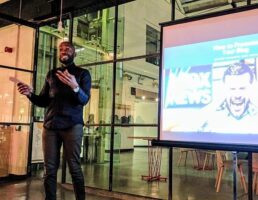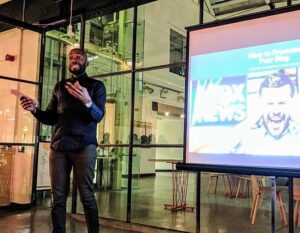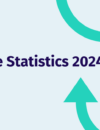
We interviewed Richard Etienne, Head of Communications and BAME Network Co-Chair at the Department of International Trade.
To start off, tell me a bit about your role at the Department for International Trade.
At the International Trade Department, I am the Deputy Head of Internal Communications and part of that is being Head of Leadership Communications. That is, for the most part, providing our senior civil servants and Secretary of State with consultation on best practice for communicating with the 4500 staff we have worldwide on matters including policy, wellbeing and diversity and inclusion.
Why is having a D&I or BAME representative in every company so important?
Well, if diversity and inclusion had a slogan, it would be, “I see you”. It’s something I had mentioned at a Civil Service Live event last year in Exeter, and it really resonated with those in attendance, mainly because D&I strategies are in place to inform the structures of the organisation to make sure that there’s parity for everyone with their protected characteristics. It’s crucial to ensure that everyone is seen for their talent regardless of their background, socioeconomic status and beliefs. From a BAME perspective, it’s incredibly important to get race equality right in the UK, because according to the Race in the Workplace 2017 paper, the BAME contribution to the economy is worth £24 billion a year. That’s just a small fraction or reason of argument for having D&I structures in place in the workplace.
How do you ensure that everyone’s voices are heard within an organisation?
Within the Department for International Trade, there are a number of diversity networks that cover the spectrum of protected characteristics. These include disability, gender, BAME, LGBT+ and it often covers other factors like parenting and neurodiversity.
What does diversity and inclusion mean to you?
In an inclusive culture, team members feel valued, respected and accepted as individuals and are therefore encouraged to fully participate and contribute as their authentic and unique selves. I guess it also links as well to my first answer about ensuring everyone is seen. It’s a cause to be celebrated. All of us have a lot to give to society. The mere fact that we were hired into that company shows that we have the talent to do that. So, it really is important for employers to continue acknowledging that talent and leaning into the benefits that diversity of thought and personnel brings to any organisation.

What changes do you expect to see within diversity and inclusion in the future?
This is a good one because the focus when it comes to the next industrial revolution, let’s say, is automation.
So Artificial Intelligence (AI) is a big focus and I can see us using AI to remove unconscious bias in processes such as recruitment selection and performance reviews.
I understand however, there is the argument that a human has to program it in the first place, so the biases of that particular individual needs to be considered as well. For that reason, I think AI and diversity and inclusion has some way to go. This even extends outside, into things like security, policing, where cameras only pickup facial recognition or it picks up one particular race over another and so forth. So that’s an open but exciting argument, AI.
Also, I think that measuring the success of teams and their leaders based on the level of diversity within a particular team or area is important.
I’ve also been in touch with marketing agencies that would only allow companies to pitch to them, who have a D&I strategy within their organisation and are seen to be implementing it, otherwise they won’t take on the account. So, I think that’s one of the really exciting and necessary things that to look forward to in the future for D&I.
What advice would you give to someone who wants to set up a BAME network within an organisation?
First of all I’d say, “Well done. Congratulations”. It’s a great first step because staff networks are important. They have great potential to shape the culture and behaviour of its organisation, so that’s great.
I would also say to first, understand why you’re setting one up. Is it because you want to retain the talent you have? Is it because you want to attract new talent? But why? Understand why you’re doing it.
Have strategic vision and understand your key milestones. Not just saying a fluffy kind of mission statement, but for example have, “We want to increase our disability staff members by 25% by 2021”. This is a clear objective and milestone set in place.
For example, with DIT, I’m the Co-Chair of the BAME network and our objectives are very clear. Our first objective, is to empower the BAME workforce and create a sense of community. Our second, is to challenge the DIT structure to achieve parity for BAME staff.
With my communications hat on, it’s very important to keep members informed at all times. That includes any new policy that we’re trying to influence or change, any consultants that we report on or any research or evidence that we may require from our members.
Also, on that point, it’s important to be very respectful of your members’ time and be very transparent with what the data collected from your members will be used for. For example, we have listening circles where we allow people to pop in and be very open about particular subject matter. We then take that away to HR, put together a list of recommendations for our Permanent Secretary, who is the most senior person within our departments, and then relay that progress to our members.
Last but not least, have fun! Create events and moments to get members together and encourage networking. It helps to increase morale and overall it just helps to really solidify why you’re doing this and remind yourselves, or yourself as Chair or Co-Chair of the committee, why this is so important.
If you would like to get in touch with Richard via LinkedIn, click here.





